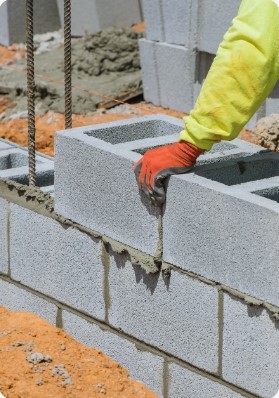Render and concrete blocks
 Magarey Enosh Universe employs professional foreign workers in a range of skeleton frame and finish works in the construction sector. Construction is a fascinating field that combines engineering, architecture and building materials. Cinderblocks are one of the most important components for the construction process and are used for building structural walls. Cinderblocks are used because of their good properties, simple maintenance, safety and economic advantage of using them for construction. Cinderblocks provide the structure its strength, thermal and acoustic comfort and fire protection. Cinderblocks withstand extreme weather and have a long lifetime.
Magarey Enosh Universe employs professional foreign workers in a range of skeleton frame and finish works in the construction sector. Construction is a fascinating field that combines engineering, architecture and building materials. Cinderblocks are one of the most important components for the construction process and are used for building structural walls. Cinderblocks are used because of their good properties, simple maintenance, safety and economic advantage of using them for construction. Cinderblocks provide the structure its strength, thermal and acoustic comfort and fire protection. Cinderblocks withstand extreme weather and have a long lifetime.
There are several types of cinderblocks, each of which is characterized by unique properties. The selection of which block to use for building a project sometimes depends on the structural needs and goals, the project budget and its construction method.
What types of cinderblocks exist?
A black cinderblock is considered a cheap, standard block and is the most popular one used in Israel. It is made of a mixture of gravel, sand and concrete. The mix is cast into (shaped) molds), the block is cured. During is a chemical process that improves the block’s properties and allows the mixture to gain its strength more quickly. The black cinderblock is used mostly for building partitions.
The advantages of the black cinderblock lie in its high bearing capacity, good bonding to render / mortar, attractive price and easy workability. On the other hand the black cinderblock does not provide thermal insulation.
A white cinderblock, known in Israel as the Ytong block, consists of a mix of sand, concrete, water, lime and expanding agent that expands the material up to twofold in volume. The mix is poured into a large mold and cut after a few hours to the desired block size.
The advantages of the white cinderblock lie in its water and fire resistance and its high acoustic and thermal insulation, blast resistance and environmental friendliness. The white cinderblock is easy to cut and may have many render types applied to it. It is considered easy and convenient to work with as it is made of homogenous materials. White cinderblocks will commonly be used for building and designing of interior / exterior partitions and building structural walls. The white cinderblock is also suitable for loadbearing construction and sometimes eliminates the need for casting columns and beams.
A silicate block, which is assembled by male-female coupling, is very convenient and easy to install on the ground, is made of lime, sand, concrete, water and expanding agent. The casting is made in a mold according to the desired block size and is then cured. The advantages of the silicate block lie in high acoustic insulation and being easy to work with on the ground. However, it is relatively heavy and expensive. Silicate blocks will usually be used in industrial buildings, for acoustic fences and yards.
The hempcrete block is considered as a rigid construction block and is used as a key thermal and acoustic insulator. The block is made of natural materials such as natural lime and industrial hemp, has an ability to regulate humidity in spaces and maintain a balanced humidity level, does not contain toxic materials and contributes to clean, healthy indoor air. The hempcrete block contributes to energy efficiency and allows for saving in costs of building heating / cooling. The block is fire resistant and is made through an exacting process.
An insulated, strong, high quality and environmentally friendly thermal pumice block is made of natural material called pumice aggregate that originates from rapid cooling of (volcanic) lava. The lava that sets forms air pockets in the block that effectively serve as the insulation layer. The pumice block made of set lava combined with concrete materials yields an insulative, lightweight and strong construction block. The aggregate’s properties is compounded by cement, which gives excellent hardening with a concrete building skeleton frame, preventing cracks from forming in walls. Usually, a thermal block will be used as an additive in making building bricks and concrete slabs. It may also be used for esthetics and landscaping owing to its porosity.
A lintel block used for casting of columns and horizontal concrete belts. Working with a lintel block makes it unnecessary to prepare molds for concrete castings. A lintel block can be purchased as white and black cinderblock alike.
Another block that is used is a split face block, which has a natural stone appearance and is usually offered in a range of colors. During construction of walls, blocks will be bonded to each other using a natural joint. The block itself contains voids that are used to allow plumbing lines to pass through them. A block of this type has high absorption ability and will usually be used in industrial structures.
A polystyrene block is one used in hollow molds for construction of walls. The molds connect to each other at a high fit level and are combined with steel bars that are driven into the blocks, onto which concrete is cast. Using polystyrene blocks is a quick construction technique, providing a very high acoustic and thermal insulation level. Combining continuous casting with cinderblocks may form a high quality retaining wall that withstands blast and earthquakes. A block of this type is easy to use and plumbing lines may be passed through it by very simple cutting.
